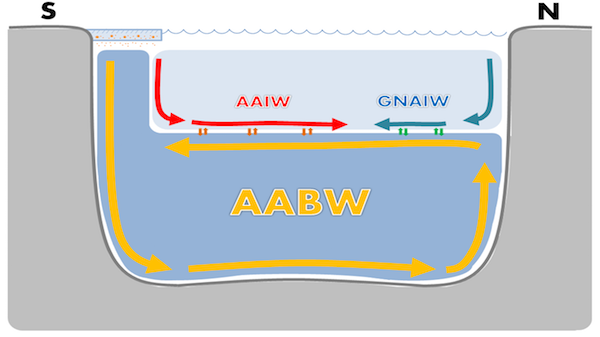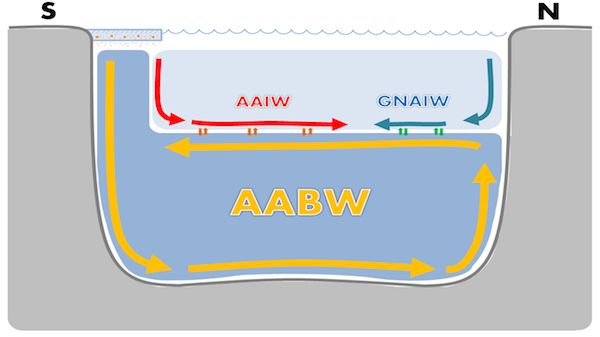How did deep Atlantic water masses evolve in the last 21 thousand years?

What happened to the ocean circulation when all this meltwater entered the ocean at that time of deglaciation? This is what Marson et al. (2015) discuss in their study published last October in Climate Dynamics.
Recently, the accelerated retreat of a glacier located in northeast Greenland has made news headlines. Besides its potential to increase the current sea level, there is another concern that surrounds the rapid melting of the Greenland ice sheet: the effect of freshwater discharge on the ocean circulation, particularly the Atlantic Meridional Overturning Circulation (AMOC).
Rahmstorf et al. (2015) reported a slowdown of the AMOC from the 1970s to the 1990s, pointing this phenomenon as the cause for the cooling trend observed south of Greenland in the last decades. In turn, the AMOC slowdown may be caused by the accelerated melting of the Greenland Ice Sheet, which hinders the formation of one of the main dense water mass that participates in the AMOC: the North Atlantic Deep Water (NADW). In order to study the impacts of meltwater on the ocean circulation, we might as well look at the (far) past. Twenty-one thousand years ago (21 ka), ice sheets covered the North America and parts of Europe. Eventually, these ice sheets melted, rising the sea level by 120 m and giving place to the geography we observe today.
The authors analyzed how the dense waters changed their properties subject to meltwater discharges and, ultimately, which were the impacts of those changes in the AMOC, using a NCAR-CCSM3 transient simulation (He, 2011). Results showed that the NADW from 21 ka was quite different than its modern counterpart. That is why a different name was given for this past NADW version: the Glacial North Atlantic Intermediate Water (GNAIW). Although it was colder, GNAIW was shallower than NADW. It shared the intermediate ocean layers with the Antarctic Intermediate Water (AAIW). GNAIW’s displacement in the water column probably happened because the glacial dense water formed in the Southern Ocean, i.e. the Antarctic Bottom Water (AABW), was much denser (much saltier) and expanded than the modern one, occupying most of the water column across the Atlantic Ocean (Figure 1). After most of the meltwater had entered the North Atlantic around 15 ka, it was transported southwards via AMOC and finally reduced AABW’s density, allowing the NADW to sink deeper and expand more southward (Figure 2). Around 11 ka, at the onset of the Holocene, the NADW features already resemble the characteristics of the modern one and, as a consequence, AMOC reaches is present strength and geometry.
Written by Juliana Marson and Mauricio Mata
Figure 1: AMOC schematic proposed configuration at the Last Glacial Maximum. S and N indicate south and north, respectively. AABW: Antarctic Bottom Water; AAIW: Antarctic Intermediate Water; GNAIW: Glacial North Atlantic Intermediate Water

Figure 2: Schematic modern configuration of the AMOC. S and N indicate south and north, respectively. AABW: Antarctic Bottom Water; AAIW: Antarctic Intermediate Water; NADW: North Atlantic Deep Water.

References:
He, F. (2011). Simulating transient climate evolution of the last deglaciation with CCSM3. PhD thesis, University of WisconsinMadison
Rahmstorf, S., Feulner, G., Mann, M. E., Robinson, A., Rutherford, S., & Schaffernicht, E. J. (2015). Exceptional twentiethcentury slowdown in Atlantic Ocean overturning circulation. Nature Climate Change, 5, 475–480, DOI:10.1038/nclimate2554













